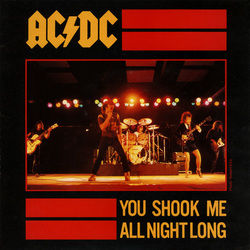

- You shook me all night long chord how to#
- You shook me all night long chord download#
You shook me all night long chord download#
After you complete your order, you will receive an order confirmation e-mail where a download link will be presented for you to obtain the notes. has over 11,000 lessons covering everything a beginner guitar needs to know to get started, as well as more complicated techniques like tapping, sweeping, scales, and more.This week we are giving away Michael Buble 'It's a Wonderful Day' score completely free.
You shook me all night long chord how to#
You can also learn from this advice about how to emulate other guitarists’ and bands’ styles by applying the same key principles and asking yourself the same key questions about their sound.Īlex Bruce is a writer for. If you follow this advice, you’ll be AC/DC-ing it up in now time. It’s partly what makes them memorable, and he definitely has his own bag of tricks-often fast, repetitive licks. Many of Young’s solos are in very deliberate phrases, or licks.
Bag of Licks!-A lot of the time, we’re trying to improve our soloing by making it feel less like a sequence of licks and more like a cohesive solo. A good excuse to develop or revise your legato playing! Loads of slides, hammer ons and pull offs, enabled of course by the sustain provided by the underlying power, volume and to an extent, gain. Lots of Legato-Legato playing is crucial to this style. One jazzy note choice and the authenticity is gone. However, if our aim is to emulate the style, we need to be in his patterns, not our own. 
In a way, there’s nothing wrong with this, that’s what Angus Young himself does, and part of why his guitar sound is so distinctive.
Pentatonic Scales-It doesn’t take much for any of us, when soloing, to fall into our own familiar patterns-our usual licks, moves and note choices. This naturally adds anticipation, growing intensity and expression-the sense that the solo is ‘climbing’ Climb the Neck-Constructing solos that begin low down the neck, then work their way up as they progress. But the key elements are held in the patterns of behavior in Young’s soloing. Though Angus Young often sticks to pentatonic scales when soloing, he rarely sticks to one area of the neck.Īnother point that could be discussed forever. 
If you don’t already know them, learn the remaining four positions of the minor pentatonic scale (how to play the same scale elsewhere on the fretboard so the whole neck becomes open to you). You probably know position 1 of the minor pentatonic scale, nearly always the first scale a rock-oriented guitarist will learn. Many of the solos in AC/DC tunes are based on pentatonic scales, particularly the minor pentatonic scale-the heart of classic rock soloing. Now, we move more toward the lead guitar element. The essence of the point is that once you’re on the right sound and using the right kind of chords, don’t forget to add expressive and rhythmic interest to create a better, more interesting and more authentic guitar part. Sliding from one chord to another, chords with bass notes hammered onto from on open string, low-end legato riffs between chords etc.Īs before-the list goes on. This breaks things up, creates rhythmic interest and creates space for interplay with the lead guitar.
Lots of gaps, pauses, staccato beats and stop/start playing in the rhythm parts. Strongly accenting certain beats, particularly less obvious beats, to make a dynamic, exciting rhythm. What does the band do to make these power chord-based rhythm guitar parts more interesting? Well, it’s mostly about adding rhythmic or expressive interest. Here’s a bit more elaboration on the above. If you get the sound right as above, and blast out some power chords, you’ll be well on the way. So, power chords are your route into the style. However, very often the parts will be power chords with a changing bass note, or power chords with a riff played in the gaps, and so on. This means that they provide a more driving, dynamic element to a song than an emotional one.Īgain, this is a starting point-AC/DC guitar parts often involve plenty more than just power chords. These are famous for their heavy, low-end sound and their being technically neither major nor minor. Particularly the most common power chords, the ‘root and fifth’ kind. The Secrets Behind Angus Young's Guitar Tone on AC/DC's "Hells Bells". (Image credit: Rob Monk/Classic Rock Magazine)







 0 kommentar(er)
0 kommentar(er)
